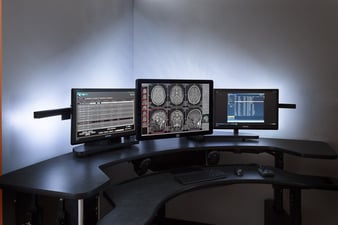 Your eyes are precious and extremely valuable, so it makes sense to take safety precautions when you engage in activities that could potentially damage them. For example, when you play racket ball, use a weed wacker, or operate a grinder, you most likely use eye protection.
Your eyes are precious and extremely valuable, so it makes sense to take safety precautions when you engage in activities that could potentially damage them. For example, when you play racket ball, use a weed wacker, or operate a grinder, you most likely use eye protection.
That being said, what do you do to protect your eyes in the reading room? I know that there isn’t any flying debris or any balls that could assault or damage your eyes in the confines of your dark reading room. However, at the end of the day, are your eyes tired and watering, and/or do you have a headache?
If your answer is yes, please read on.
What causes eye strain?
If you’re a physician, I don’t have to explain to you the mechanics of the iris in your eye, but for the layman reading this blog, I’ll provide a simple medical explanation of the iris:
The iris (plural: irides or irises) is a thin, circular structure in the eye, responsible for controlling the diameter and size of the pupil and thus the amount of light reaching the retina.
The iris is the colored part of the eye. In the middle of the iris is an opening called the pupil that controls the amount of light entering the eye. The iris operates with the retina to allow the eye to function over a wide range of light levels. We also use pupil movements in non-verbal communication, invariably at a subconscious level.
The iris wants to ensure that the correct amount of light enters your eye by increasing the size of the pupil in a dark environment and decreasing the size of the pupil in a bright environment.
If the iris becomes overactive and has to frequently change the size of the pupil because it’s trying to over-regulate the size of the pupil, you experience eye strain.
Why would eyestrain be an issue in a reading room?
Let’s say you are looking at a chest, which is a bright image on your LCD monitor, and the background light behind your monitors is dark because you have all of the lights off in your reading room (which is typical).
Every time you look from the bright screen to the perimeter of your monitors, your irises are going to react. In the course of a day, this could constitute unnecessary pupil contraction and extraction, resulting in eye strain. The opposite is true when viewing a dark image.
Is there a way to prevent eye strain?
The remedy for the above example is simple: bias lighting. If you have lighting behind your LCD monitors that can be increased or decreased depending on the brightness of the digital image you are interpreting, you will dramatically reduce the over-reaction of your irises, thus reducing strain on the eyes.
Are there any other causes of eye strain that I should be aware of in the reading room?
Another reason you might experience strain in the reading room is due to the focal distance from your LCD monitors. Many times during the course of interpreting an image, you need to get closer or farther away from your monitors. However, this is a challenge with most imaging desks, as the monitors are on stationary stands or individual arms. Moving one to four monitors on stationary stands is a chore, and as all of us know, it’s not one you are going to perform.
Instead, you are going to lean forward or back, creating other ergonomic issues or muscular-skeletal injuries over the course of time. In the case of individual LCD arms, moving one to four monitors on individual arms is also quite a challenge. This can result in unaligned monitors, and continued adjustment of the LCD arms can lead to sagging or non-functioning arms.
What’s the best solution for this scenario?
The remedy for this example is also simple; select a manufacturer that incorporates ideal mechanics, meaning that you will be able to move all of the monitors’ focal depth at the same time.
Conclusion
Eyestrain, along with the irritating symptoms it causes, can be easily reduced by selecting an ergonomic imaging desk that incorporates bias lighting and focal depth adjustment along with the many other amenities that you require in the ideal imaging desk.



